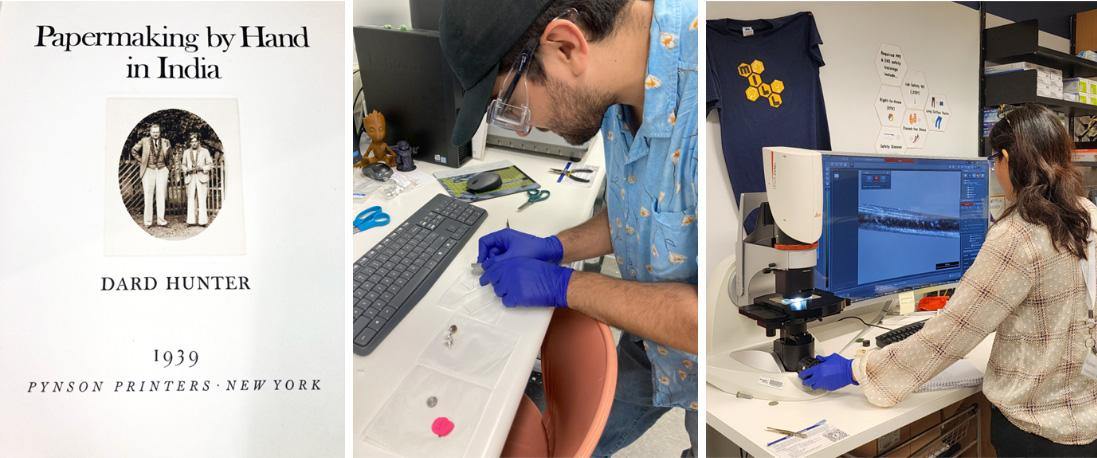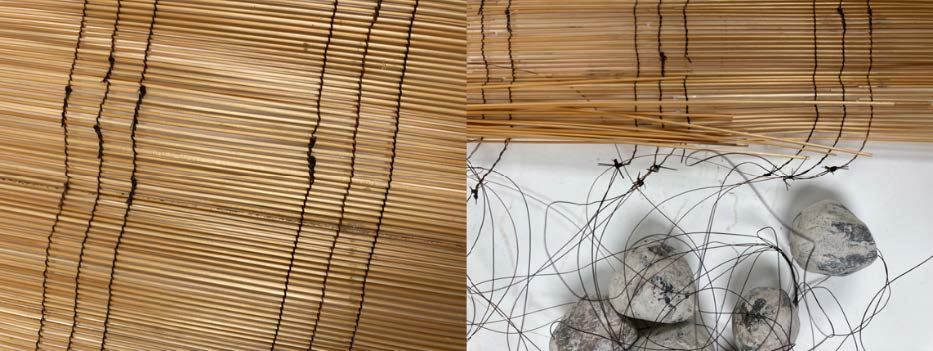Splitting Hairs : Identification of Unknown Materials of a Historic Papermaking Tool Through Forensics Fiber Analysis
Sep 10, 2023 — Atlanta, GA

Picture of Dard Hunter and Tekumalla Venkajee during their travels in the Indian subcontinent (left). Daniel Vallejo, Ph.D., prepping the loom fiber sample for Scanning Electron Microscopy (middle), Nasreen Khan, Ph.D., analyzing loom fiber with an optical microscope (right) in Georgia Tech Microscope
Who We Are and the Paper Museum
The Robert C. Williams Museum of Papermaking houses hand papermaking artifacts from around the world. Dard Hunter, a renowned paper historian and founder of the museum, collected many of these objects throughout the early 1900s as he sought to gain more knowledge about this craft. Nearly 100 years later, the museum continues its mission to collect, preserve, increase, and disseminate knowledge about papermaking to the general public. By collaborating with Georgia Tech researchers, and the larger Atlanta community, by using scientific tools, we can unlock hidden information held within the objects, both from a historical and scientific perspective. Recently, two Georgia Tech Postdoctoral Fellows, Nasreen Khan (Paper Museum/RBI) and Daniel Vallejo (School of Chemistry and Biochemistry) sought to uncover more about a loom in the museum’s collection, connected with the history of the Indian subcontinent and Gandhi.
Dard Hunter and Background of the Loom
In the 1930s, Dard Hunter traveled to Asia and the Indian subcontinent (I.e., India, Pakistan, Bangladesh, Kashmir) to document hand papermaking techniques and collect tools and paper samples. At that time many people, including Mahatma Gandhi, aimed to revitalize the Indian hand papermaking tradition by supporting and creating schools to teach the craft [1-3]. Dard Hunter visited several papermaking villages and schools, including those helped founded by Gandhi. Hunter brought a loom back to America that was used to weave a chapri (paper-mold cover or screen), but the information of the specific origins of this loom was lost.
What’s Missing?
While Hunter and other researchers documented and studied hand papermaking tools and materials of this region and time, it was primarily from a historical and cultural perspective [1-5]. Much of their focus has been on the plant materials used to make the paper and molds [1-5]. However, some parts of the handmade molds in Asia were known to also use biological materials sourced from animals, such as silk and animal hair [1-4]. Since the exact origin of the loom and the fibers used to construct the paper mold was not known, the museum was interested in learning more about this object.

With scientific tools, the study aimed to understand more about the fibers commonly used in traditional handmade paper-mold covers in the 1930s Indian subcontinent by using scientific tools. With the availability of high-resolution microscopy technologies and historical documentation at Georgia Tech and the Museum, researchers aimed to either prove or disprove whether the origin of preserved fibers on the loom was from an animal and determine with historical context where the loom was acquired.
What we did and what we discovered
Are the Fibers Really Horsehair?
In forensic analysis, typically the first step to identify unknown fiber or hair samples is to conduct microscopy. Microscopy, or the science of using microscopes to view samples & objects that cannot be seen with the naked eye, is the gold standard for analyzing and identifying unknown fibers by comparison to a library of known reference materials. This is possible because hair from different sources or animals have different “morphologies”, or physical features, that help identify their origin. Thanks to the Materials Innovation and Learning Laboratory (MILL), a hub of scientific equipment for hands-on scientific training of undergraduates at Georgia Tech, the researchers were able to use two different microscope techniques: Light microscopy and Scanning Electron Microscopy (SEM). Thanks to Little Creek Farm Conservancy in Decatur and Kristine Parson, the researchers were able to obtain reference materials for tail and mane horsehair from two horses: Angus and Lightening.
Click the link below to continue reading the story.
Virginia Howell | |Director of the Robert C. Williams Museum of Papermaking




